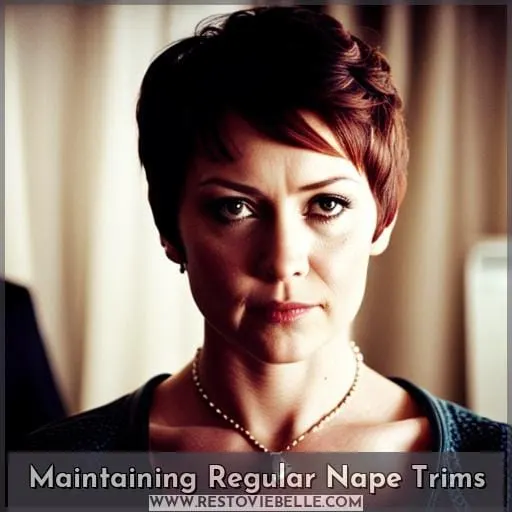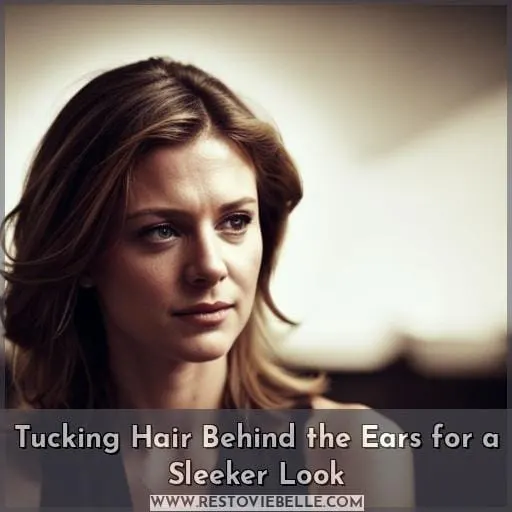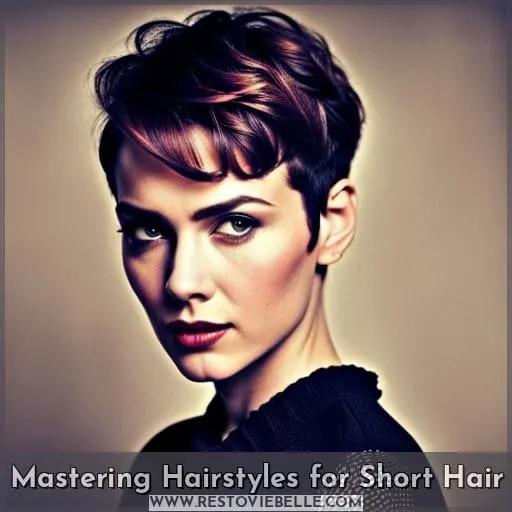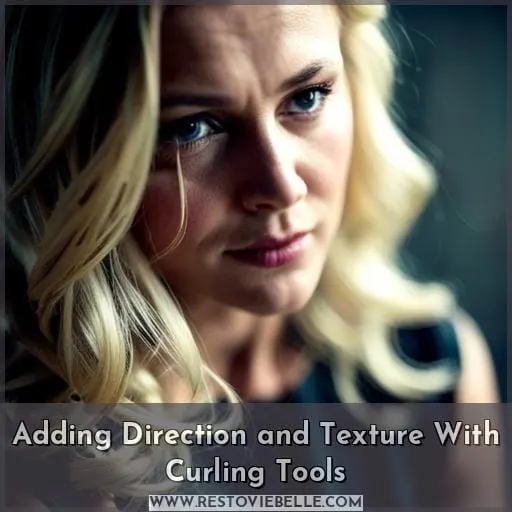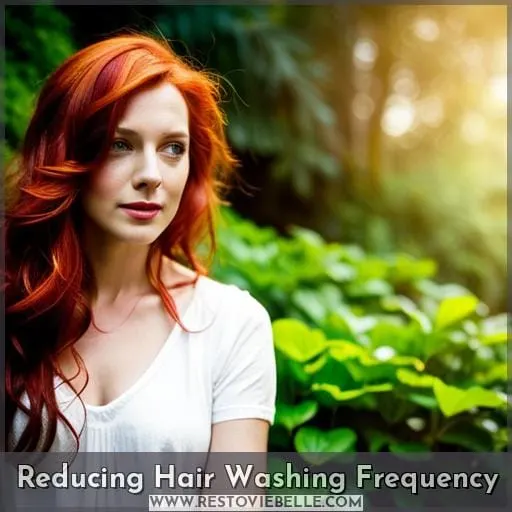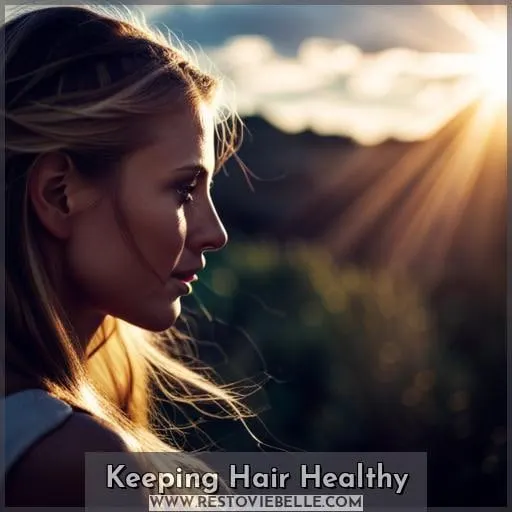This site is supported by our readers. We may earn a commission, at no cost to you, if you purchase through links.
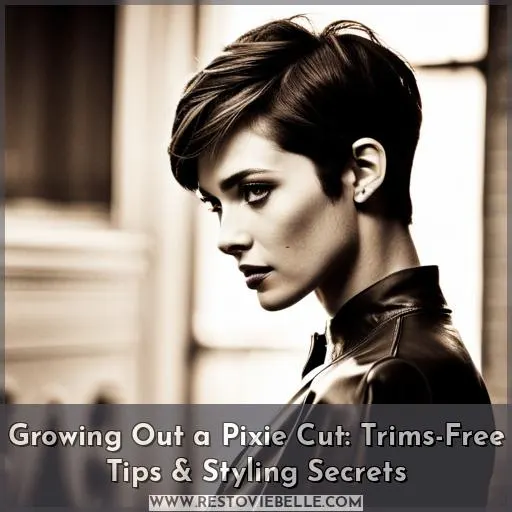 If you’re looking to take the plunge and grow out your pixie cut, you’ll want to put on your thinking cap. Growing out a pixie cut without trims is no small feat – but it can be done! With these tips and styling secrets, we’ll have you rocking longer locks in no time.
If you’re looking to take the plunge and grow out your pixie cut, you’ll want to put on your thinking cap. Growing out a pixie cut without trims is no small feat – but it can be done! With these tips and styling secrets, we’ll have you rocking longer locks in no time.
From understanding the growth timeline to mastering hairstyles for short hair, here’s everything you need know about growing out a pixie cut with success.
So buckle up; this journey could require some patience – but don’t worry: if there’s one thing we’ve got plenty of right now it’s that!
Table Of Contents
- Key Takeaways
- Understanding the Growth Timeline
- Maintaining Regular Nape Trims
- Styling Tips for Redistributing Bulk
- Tucking Hair Behind the Ears for a Sleeker Look
- Mastering Hairstyles for Short Hair
- Choosing the Right Styling Products
- Adding Direction and Texture With Curling Tools
- Reducing Hair Washing Frequency
- Keeping Hair Healthy
- Embracing the Process With Confidence
- Conclusion
Key Takeaways
- Growing out a pixie cut without trims requires patience and time.
- Styling options like headscarves, braids, and hats can help manage the growing phase.
- Use styling products and techniques to control and style the hair during the transition.
- Maintaining a healthy diet and considering supplements like biotin can promote hair growth.
Understanding the Growth Timeline
You can expect a transformation of your style over the 6-month to 1-year timeline, so get creative with different hairstyles and accessories as you go!
On average, the hair growth rate is 15cm (6 inches) per year. Accelerating this process depends on genetics and the type of pixie cut.
Patience is key during this period. Try styling products like cream, gel, or mousse to keep control while experimenting with headbands, buckles, or hats for variety.
A healthy diet rich in protein, zinc, and essential vitamins will help promote healthy growth too.
As you reach the 8-9 month mark, transitioning from a shaggy bob towards a stylish bob becomes easier by maintaining nape trims regularly along with oil treatments once a week for replenishing follicles.
Finally, embrace the length on the sides of your face, visualizing reaching a stage where a ponytail becomes possible!
Maintaining Regular Nape Trims
To keep your style looking polished, schedule regular trims at the nape of your neck every 2-3 months. A professional stylist can help you avoid over trimming and will be able to give recommendations for how often you should visit them for a trim.
When maintaining regular trims, make sure they are only slight adjustments – no more than 1/4 inch each time – so as not to take away too much length in one go and set back progress towards longer hair overall!
Here’s what else is important when it comes to keeping up with nape trims:
- Make sure scissors used are sharpened regularly.
- Avoid using razor blades or clippers on delicate areas like around the ears.
- Use styling products such as mousse before cutting any stray hairs.
- Take breaks between cuts if needed so that mistakes aren’t made by rushing through the process.
All these steps add up in helping you grow out your pixie cut without needing additional trims along the way while still achieving an even look at all stages of growth!
Styling Tips for Redistributing Bulk
Experiment with different hair parting styles to give your look a balanced shape and redistribute bulk. Try out bobby pin tricks, scarf styles, curling techniques, and extension options to style your pixie cut while growing it out without trims.
To stimulate healthy hair growth from the roots, consider scalp massages or vitamin supplements like biotin. Incorporate oil treatments 1-2 times per week to replenish follicles and promote longer locks over time.
Get creative with styling on social media platforms such as Instagram. There, you’ll find endless ideas for headscarves, headbands, and hats that can help conceal awkward lengths at each stage of the growing out process.
Tucking Hair Behind the Ears for a Sleeker Look
For a sleek, polished look, try tucking your longer Pixie hair behind the ears. This can help redistribute bulk and create an even silhouette overall.
You may also consider adding some elegant earring combinations or trying out trendy ear cuffs to complete the look. When selecting jewelry for this style, make sure it complements your hairstyle and doesn’t overpower it too much with sparkles or bold colors.
If you’re feeling daring, why not experiment with some creative earlobe tattoos? For those who prefer more subtle looks, they might like experimenting with different makeup techniques on their ears instead, such as ombre effects or glittery highlights!
No matter which route you choose for styling when growing out your pixie cut between tucks and trims, be sure to maintain a good hair care routine.
During this transition phase of your journey, don’t forget to have fun exploring different styles that flatter both face shape and neckline.
Mastering Hairstyles for Short Hair
When it comes to growing out a pixie cut without trims, mastering hairstyles for short hair is key.
Headscarf styles can be used to add texture and color, while braided options create an interesting look that draws attention away from the awkward lengths.
Hats and bandanas offer unique ways to control your hair length by hiding grown-out bangs or tucking longer pieces behind ears for a sleeker silhouette.
Clip techniques such as invisible pins or barrettes can also be used in combination with headbands or scarves for more intricate looks as well!
Hairpin ideas provide extra volume when needed, adding instant style with minimal effort – perfect for days when you want something easy yet polished looking at the same time!
To ensure healthy growth during this process, make sure you prioritize scalp care through massage and oil treatments.
Choosing the Right Styling Products
When growing out a pixie cut without trimming, styling products and accessories can help you make the most of your look while maintaining hair health. Gels and texturizers are great for creating short hairstyles with control, while headbands or other invisible pins provide variety to keep looks fresh.
Additionally, dietary supplements like biotin can be taken to boost hair growth during this process.
Styling products for control
Discover the styling products that can instantly give you control over your short hair for a polished look! Consider gels and texturizers to create new pixie styles, or use a strong-hold gel and clips to secure longer locks.
Experiment with different partings, headbands, pins, or hats for variety. Pay special attention to product selection; pick one that suits your texture and provides hold without compromising volume.
Accessories for variety
Explore how accessories like invisible pins, bandanas, and hats can give you a variety of looks as your pixie cut grows out! Headband styles add dimension to short hair; hat choices let you express yourself; bandana trends keep it fresh.
Maintaining hair health
To maintain hair health while growing out a pixie cut, consider taking biotin supplements – they can help increase the rate of hair growth by up to 2-3 times! Use conditioner after washing and incorporate oil treatments 1-2 times a week.
Stimulate hair growth with scalp massages and nutrient-rich dietary supplements. Be cautious of heat styling tools; use a heat protectant product when necessary. For extra shine and texture, try using creative extensions or wigs for versatility in style options.
Adding Direction and Texture With Curling Tools
Add some shape and flair to your look by using a curling iron or flat iron! Curling tools are the perfect way to add direction and texture, as well as styling versatility for short hair. With a few simple techniques, you can easily master these tools and create stunning textured styles that will make growing out a pixie cut more enjoyable.
Here’s what you need to know:
- Invest in heat protection products before applying any heat tool on your hair. This is essential for preventing damage from high temperatures while still achieving salon-worthy results at home.
- Experiment with different curl sizes when styling short hair – tight curls will give maximum volume while looser ones offer an effortless tousled look.
- Don’t forget about accessorizing; use head scarves, hats, or clips for added dimension throughout the transition process without compromising length growth goals too soon!
Lastly, remember practice makes perfect, so don’t be afraid of experimenting with various hairstyles during this period of time as it may lead to greater confidence in self-expression later on down the road.
Reducing Hair Washing Frequency
Reducing hair washing frequency is an important step when growing out a pixie cut without trimming. Incorporating oil treatments and hair masks into your routine, as well as stimulating hair growth with scalp massages and vitamins, can help promote healthy growth during the process.
Therefore, it’s beneficial to be mindful of how often you wash your short locks so that they don’t become weighed down or poofy over time.
Incorporating Oil Treatments and Hair Masks
Pamper yourself with oil treatments and hair masks every week to keep your ‘do looking fierce, even as you grow out that pixie cut! Oil treatments help improve the look of split ends, reduce frizziness, add shine, and protect from heat styling.
Hair masks provide deep conditioning benefits for added hydration and nourishment to brittle locks.
To maximize effectiveness, combine an oil treatment followed by a hydrating mask once per week.
Accessorize with clips or headbands while incorporating coloring techniques like balayage highlights, which can give dimension to short styles while growing out bangs.
Stimulating Hair Growth With Scalp Massages and Vitamins
Unlock your hair’s potential with invigorating scalp massages and nourishing vitamins. Scalp massage benefits include increased blood circulation, which promotes healthy follicles for natural hair growth progression.
Vitamin supplements can also help provide essential nutrients, such as zinc and biotin, necessary for strong strands.
For an extra boost of hydration, try incorporating oil treatments or a weekly mask to replenish the scalp and stimulate new growth while styling short hairstyles during the growing-out process of a bob cut.
Keeping Hair Healthy
Maintaining a healthy and balanced diet is essential when growing out a pixie cut without trims, as it helps keep hair strong and resilient. Eating foods rich in protein, zinc, vitamins A and C, as well as taking biotin supplements, are all key components to maintaining the health of your hair during this process.
Maintaining a Balanced Diet
Nourish your body with essential vitamins and a balanced diet to support the growth of healthy hair. A nutrient-rich diet, full of colorful fruits and vegetables, can make all the difference in how quickly your pixie cut grows out.
Incorporate these key elements into your meals: lean proteins, whole grains, seeds & nuts, as well as omega-3 fatty acids from fish like salmon or cod for optimal hair health.
Eating a variety of foods will ensure that you are getting enough micronutrients necessary for maintaining overall health and strong locks! Make sure not to miss out on important dietary groups such as dairy products, which provide calcium required for bone density and strong nails.
Avoiding Heat Styling and Chemical Treatments
Be sure to keep your heat styling and chemical treatments at bay if you want to sail through the growing out process for your pixie cut. Avoiding these methods of hair care will help preserve natural oils, reduce damage, and promote healthy growth.
Protective hairstyles can also be used as an alternative option that helps protect fragile ends from breakage while still allowing you to look stylish and trendy. Developing healthy habits, such as avoiding over-washing, using deep conditioning masks biweekly or monthly, and incorporating oil treatments into your routine 1-2 times a week, are simple yet effective ways of ensuring long-lasting hair health during this transition period.
Taking extra time now by investing in protective styles like twist outs or bantu knots will pay off in the end when it comes time for displaying those luscious locks!
Embracing the Process With Confidence
Boost your spirit and show off your new look with confidence as you journey through the process of growing out a pixie cut! Having a positive mindset is key to embracing change.
Look at this experience as an opportunity for self-discovery; who knows what hairstyles will suit you best? Build up your inner strength by celebrating every small victory along the way, even if it feels like progress is slow.
Let go of any negative thoughts about how long this process takes and focus on how great it will feel when everything comes together perfectly! Focus on building self-esteem rather than worrying about mistakes or setbacks, because success isn’t always linear.
Conclusion
It’s a long and winding road, but growing out a pixie cut without trims can be done. With patience, creativity, and a few essential tips, you can maintain a polished look while transitioning from a pixie to a longer hairstyle.
Understanding the growth timeline is crucial. Experimenting with different hairstyles and styling products will help you find what works for you. Regular nape trims, using styling products to control bulk, and tucking hair behind the ears are all essential steps for creating a sleek and stylish look.
Don’t be afraid to explore hairstyles for short hair. With a little bit of effort and knowledge, you can achieve the hairstyle you desire without compromising your hair’s health or trimming your locks.


